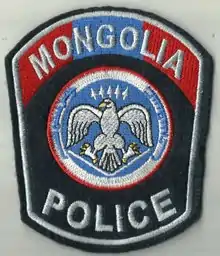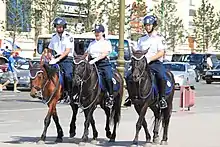National Police Agency (Mongolia)
The National Police Agency (Mongolian: Арван тавны цагдаа, Arvan Tavnii Tsagdaa, literally meaning "Preventive Soldiers") is an agency that is part of the Government of Mongolia and acts as a reserve force for the Armed Forces of Mongolia. It is currently an agency of the Mongolian Ministry of Justice and Home Affairs and is the primary law enforcement organization in Mongolia.[1] The Police is assisted by the Directorate of the Internal Troops of Mongolia.

History

.jpg.webp)
The founding day of the modern police force was on 19 July 1921, when the 6th Session of the Ulsyn Baga Khural (Little Khural) decreed to establish the "Preventive Militia" with the same mandat of modern police forces. This order came days after the Mongolian Revolution of 1921 in which Outer Mongolian revolutionaries declared the Mongolian People's Republic.
From 1934 to 1940, specialized departments were established throughout the various Aimags. From 1940 to 1960, the Prosecutor's Office instituted a law enforcement body to enforce the new Constitution of Mongolia, the Criminal Law and the Criminal Procedure Code. In the 1960s, the structure and organization of the police were expanded and in 1965, made a separate institution from the Prosecutor's Office. In celebration of the 50th anniversary of the establishment of the police, the Military Institute was established by the decree of the Presidium of the People's Great Khural on 14 July 1984. The institute now takes the form of the Law Enforcement University of Mongolia.
From its establishment until 1990s, the agency was under the joint command of the Ministry of the Interior and the Ministry of Public Security. As a result of the political and revolutionary transitions and market economy in 1990s, the police underwent a drastic transformation and was reestablished as the National Police Agency of the Government of Mongolia mandated to combat crime and maintain safety on a national basis with an International Police Department being established a year later. In 1993, the State Great Hural approved the "Law on Police" in order to establish legal basis for law enforcement.[2][3][4]
Organization
The agency is headed by a Commissioner General assisted by several Deputy Commissioners General, seniormost being the First Deputy Commissioner General.
There are also 10 departments under specific Deputy Commissioners General:[5][6]
- Administration
- Finance and Logistic
- Criminal Police
- Investigations
- Inquiry
- Traffic Police
- Information Research
- Public Order
- Communications Division
- Police Academy
Below the central level, there are Police Departments and Divisions in the 21 provinces and in Ulaanbaatar, further subdivided into Divisions, Units and Sections.[5] The largest police training institution is the Mongolian Police Academy. As in many such institutions, the police academy operates within a hierarchical structure.[7]
Ranks
The NPA utilizes the following ranks:[8]
- Upper ranks
- Commissioner General
- First Deputy Commissioner
- Deputy Commissioner
- Assistant Commissioner
- Senior ranks
- Police Colonel
- Police Lieutenant Colonel
- Police Major
- Middle ranks
- Police Captain
- Police Senior Lieutenant
- Police Lieutenant
- Junior ranks
- Police Senior Sergeant
- Police Sergeant
- Police Junior Sergeant
Symbols
Logo
The logo of the NPA is a white falcon, a Mongolian symbol of sharp eyes, bravery, and justice.[9]
Slogan
The official slogan of the NPA is: "Striving together for peaceful and secure life".[10]
Ensemble
The Suld Ensemble of the Mongolian Police (Mongolian: Цагдаагийн Сулд чуулга) was founded in 1991 as the official musical unit of the National Police Agency. It consists of a group of professional artists, all of whom are part of the Mongolian Police Academy.[11] In November 2018, a singer of the ensemble won the award at a competition for best performer of a Chinese classical song.[12]
See also
References
- "State Police Department (Mongolia) | GHDx". ghdx.healthdata.org. Retrieved Jul 12, 2019.
- "NATIONAL POLICE AGENCY - Мэдээ мэдээлэл". eng.police.gov.mn. Retrieved Jul 12, 2019.
- Refugees, United Nations High Commissioner for. "Refworld | Mongolia: Structure of the police; how a complaint about a police officer would be handled by the police (1997-September 1999)". Refworld. Retrieved Jul 12, 2019.
- "General Police Department - Танилцуулга - Монгол улсын засгийн газар - Government of mongolia". zasag.mn. Retrieved Jul 12, 2019.
- "Organizational chart National Police" (PDF). Retrieved 28 September 2015.
- "NATIONAL POLICE AGENCY - Мэдээ мэдээлэл". eng.police.gov.mn. Retrieved Jul 12, 2019.
- https://asiafoundation.org/resources/pdfs/COPsurveyreportSept08ENG.pdf&ved=2ahUKEwjLjbnfjrbpAhUMHs0KHTNrDkEQFjAGegQIAhAB&usg=AOvVaw27WBOZNVeTDaXopaA-ddTj
- http://eng.police.gov.mn/news/content/type/119
- http://eng.police.gov.mn/news/content/type/118
- http://eng.police.gov.mn/news/content/id/687/type/120/menuid/37
- http://suld.police.gov.mn/news/content/id/933/type/30/menuid/
- http://www.vom.mn/en/p/41752